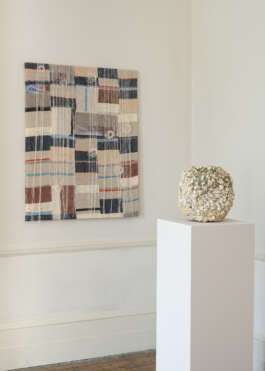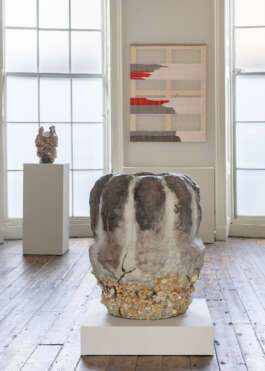



© Sonya Tamaddon
COLLECTIBLE
Three questions to
June 2024
Today we have the pleasure of speaking with Sonya Tamaddon, an independent curator and consultant based in New York. As curator of the New York CURATED section 2024, she shares with us her views on the Los Angeles and New York art and design scenes, insights to her curatorial approach, and her vision for the CURATED section of our inaugural NY fair.
COLLECTIBLE: How do you perceive the current state of the art and design scenes in Los Angeles and New York? What distinctive qualities define each city's creative landscape?
Sonya Tamaddon: Both cities offer such distinct palettes and as a result very diverse materialities come out of both places. It’s been particularly interesting to see historic and contemporary buildings designed and built by immigrants to California, such as Austrian born architects Rudolf Schindler and Richard Neutra, Mount Washington’s Sea View Gallery housed in Cuban born US based artist Jorge Pardo designed home, to Canadian architect Frank Gehry’s buildings serving as sites for exhibiting design, to the Neutra House in Silverlake’s thoughtful exhibition and residency program stewarded by my friend Noam Saragosti. We see many art and design platforms exhibiting inside an environment one can see these objects in a lived in context while also engaging with the city’s rich creative history. In New York artists and designers oftentimes out of necessity have studios out of their homes. As such they are working in a different scale and contextually in closer dialogue with Europe. We see similar impulses translate into thoughtful design exhibitions in gallery spaces that reject the notion of a traditional design exhibition space. Gallerists here in NY in recent years are choosing to occupy more domestic spaces to exhibit their roster but in NY that translates to a Tribeca loft or an Upper East Side townhouse. It’s a different history and visual language.
I’m a firm believer that the most interesting times we’re living in is the present and I think what is happening in both cities right now is a true reflection of this sentiment.
C: How do your art and design interests inform each other in your curatorial work?
ST: I started my career at LACMA in the contemporary art department, followed by the Peggy Guggenheim in Venice before working for contemporary galleries. My interest in design began later and is very informed by my background in contemporary art. I worked on an exhibition in 2016 which explored Mexican architect Luis Barragan’s influence on contemporary artists and designers and this was my entrypoint to design. Looking at Josef Albers’ butaque chairs conceived after visiting Barragan in Mexico, or Hockney’s pool paintings that emerged after Hockney visited the pool at Barragan’s Casa Gilardi. I’m fascinated by that oftentimes indistinguishable space between form and functionality, designers influencing the creative production of artists, and vice versa thus challenging artists to explore the boundaries of their practices. My work has always been engaged with this intersection and expanding upon it. My current exhibition at Tristan Hoare in London is a dual presentation of Paris based weaver Marie Hazard and Japanese ceramicist Masaomi Yasunaga. Marie rejects the functional innovations of the British Arts and Crafts movement, and reimagines her centuries old medium of weaving through a multidisciplinary approach. Masaomi is a second generation proponent of Sodeisha, a movement that was born in Kyoto in 1948 to challenge the functionality of ceramics and return them to their sculptural form. This preoccupation is a recurring theme in my curatorial work in both art and design and my presentation for Curated will be a continued expansion of this.
C: What is your overall vision for the CURATED section, and how will you select the works that match this vision?
ST: COLLECTIBLE has distinguished itself in both its curatorial approach to the fair and the accessibility of its model for participants so that the fair’s audience has a real opportunity to see and discover makers both emerging and established from different geographies. I want people to explore work they might not encounter in their usual circuit of commercial galleries and to offer insight into experiences that aren’t in the mainstream. For instance, Sophie Wahlquist is a multidisciplinary artist and designer whose primary mediums are painting and ceramic. I came to know Sophie in Los Angeles and she has recently relocated to Mallorca. Her practice’s foundational roots in Los Angeles reflect the deep ceramic traditions of the city whilst always having a surrealist quality inform the work. In her presentation we will see how new and existing themes have been expanded upon in this new context.
The U.S. is oftentimes perceived as Los Angeles and NY and I want to challenge this. I was born in London, raised in Los Angeles, and New York is currently my home. My curation will be a bridge reflecting practices in Europe where the fair has been established, with strong North American presentations, very importantly to me reflecting both Mexico and Canada within this definition. Literature has always been a great interest of mine and shaped my curatorial practice and will be the basis of the theme I engage the participants to respond to.

Installation view: Marie Hazard & Masaomi Yasunaga Courtesy of Tristan Hoare Gallery. Photographer: Rita Silva

Installation view: Marie Hazard & Masaomi Yasunaga Courtesy of Tristan Hoare Gallery. Photographer: Rita Silva

© Sonya Tamaddon
COLLECTIBLE
Three questions to
June 2024
Today we have the pleasure of speaking with Sonya Tamaddon, an independent curator and consultant based in New York. As curator of the New York CURATED section 2024, she shares with us her views on the Los Angeles and New York art and design scenes, insights to her curatorial approach, and her vision for the CURATED section of our inaugural NY fair.
COLLECTIBLE: How do you perceive the current state of the art and design scenes in Los Angeles and New York? What distinctive qualities define each city's creative landscape?
Sonya Tamaddon: Both cities offer such distinct palettes and as a result very diverse materialities come out of both places. It’s been particularly interesting to see historic and contemporary buildings designed and built by immigrants to California, such as Austrian born architects Rudolf Schindler and Richard Neutra, Mount Washington’s Sea View Gallery housed in Cuban born US based artist Jorge Pardo designed home, to Canadian architect Frank Gehry’s buildings serving as sites for exhibiting design, to the Neutra House in Silverlake’s thoughtful exhibition and residency program stewarded by my friend Noam Saragosti. We see many art and design platforms exhibiting inside an environment one can see these objects in a lived in context while also engaging with the city’s rich creative history. In New York artists and designers oftentimes out of necessity have studios out of their homes. As such they are working in a different scale and contextually in closer dialogue with Europe. We see similar impulses translate into thoughtful design exhibitions in gallery spaces that reject the notion of a traditional design exhibition space. Gallerists here in NY in recent years are choosing to occupy more domestic spaces to exhibit their roster but in NY that translates to a Tribeca loft or an Upper East Side townhouse. It’s a different history and visual language.
I’m a firm believer that the most interesting times we’re living in is the present and I think what is happening in both cities right now is a true reflection of this sentiment.
C: How do your art and design interests inform each other in your curatorial work?
ST: I started my career at LACMA in the contemporary art department, followed by the Peggy Guggenheim in Venice before working for contemporary galleries. My interest in design began later and is very informed by my background in contemporary art. I worked on an exhibition in 2016 which explored Mexican architect Luis Barragan’s influence on contemporary artists and designers and this was my entrypoint to design. Looking at Josef Albers’ butaque chairs conceived after visiting Barragan in Mexico, or Hockney’s pool paintings that emerged after Hockney visited the pool at Barragan’s Casa Gilardi. I’m fascinated by that oftentimes indistinguishable space between form and functionality, designers influencing the creative production of artists, and vice versa thus challenging artists to explore the boundaries of their practices. My work has always been engaged with this intersection and expanding upon it. My current exhibition at Tristan Hoare in London is a dual presentation of Paris based weaver Marie Hazard and Japanese ceramicist Masaomi Yasunaga. Marie rejects the functional innovations of the British Arts and Crafts movement, and reimagines her centuries old medium of weaving through a multidisciplinary approach. Masaomi is a second generation proponent of Sodeisha, a movement that was born in Kyoto in 1948 to challenge the functionality of ceramics and return them to their sculptural form. This preoccupation is a recurring theme in my curatorial work in both art and design and my presentation for Curated will be a continued expansion of this.
C: What is your overall vision for the CURATED section, and how will you select the works that match this vision?
ST: COLLECTIBLE has distinguished itself in both its curatorial approach to the fair and the accessibility of its model for participants so that the fair’s audience has a real opportunity to see and discover makers both emerging and established from different geographies. I want people to explore work they might not encounter in their usual circuit of commercial galleries and to offer insight into experiences that aren’t in the mainstream. For instance, Sophie Wahlquist is a multidisciplinary artist and designer whose primary mediums are painting and ceramic. I came to know Sophie in Los Angeles and she has recently relocated to Mallorca. Her practice’s foundational roots in Los Angeles reflect the deep ceramic traditions of the city whilst always having a surrealist quality inform the work. In her presentation we will see how new and existing themes have been expanded upon in this new context.
The U.S. is oftentimes perceived as Los Angeles and NY and I want to challenge this. I was born in London, raised in Los Angeles, and New York is currently my home. My curation will be a bridge reflecting practices in Europe where the fair has been established, with strong North American presentations, very importantly to me reflecting both Mexico and Canada within this definition. Literature has always been a great interest of mine and shaped my curatorial practice and will be the basis of the theme I engage the participants to respond to.

Installation view: Marie Hazard & Masaomi Yasunaga Courtesy of Tristan Hoare Gallery. Photographer: Rita Silva

Installation view: Marie Hazard & Masaomi Yasunaga Courtesy of Tristan Hoare Gallery. Photographer: Rita Silva
Contact
info@collectible.design
VIP PORTAL
EXHIBITOR PORTAL
PRIVACY POLICY
© 2025 Collectible
Contact
info@collectible.design
VIP PORTAL
EXHIBITOR PORTAL
PRIVACY POLICY
© 2025 Collectible